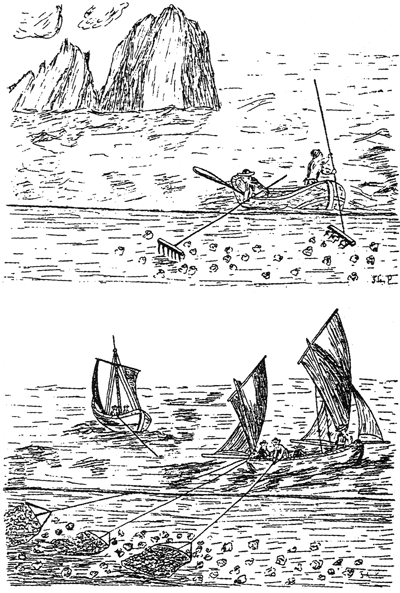Fishing dredge

A fishing dredge, also known as a scallop dredge or an oyster dredge, is a kind of fishing net. It is pulled along the bottom of the sea by a fishing boat to collect scallops, oysters and other kind of clams, crabs, and sea cucumber.[1] Fishermen then lift the dredge into the boat and empty it.
In Europe, dredges used to have "teeth" at the bottom, called tynes. These teeth raked or ploughed the sand and mud. This dug up buried clams.[1] The New Bedford (USA) dredge does not have teeth.
Dredge nets have a gross mesh in order to let organisms smaller than the target organisms through. The net catches the larger organisms: in the case of scallop dredging that includes the scallops' predators, such as whelks, starfish and octopus.
Sometimes three or four dredges are attached to a wheeled stiff axle. A number of these dredges can be towed from a heavy spreading bar. Usually there is one on each side of the ship. The length of the bar and the number of dredges towed is dependent on the power of the ship and the room on the side of the boat for working the dredges. There could be 3 on each side on a small 10 metre boat. There could be up to 20 on each side for a 30-metre ship with 1500 hp.[2] The weight and strength of this can dig up the ground. It overturns rocks and can crush animals and plants in its path.[1]
Scallops often contain sand when fishermen use dredges. It can also damage the seabed if they use dredges carelessly. These days scallop dredging is sometimes replaced by scuba diving. However inventors are trying to invent a better dredge.[3]
-
Mussel dredgers
-
Boats dredging for oysters, c. 1875
-
Oyster boats of the Truro Oyster Fleet. This fishery is the last in the world to work by sail alone
-
Oyster dredge at work, c.1875
-
Oyster Boats North River, by John Henry Twachtman (1853–1902)
-
Oyster Sloop, Cos Cob, by Childe Hassam (c.1902)
-
Dredging For Oysters, by Alexander Rummler. WPA mural.
Related pages
[change | change source]References
[change | change source]- ↑ 1.0 1.1 1.2 Moore, G.; Jennings, Simon (2000). Commerical Fishing: The Wider Ecological Impacts. Wiley. p. 14. ISBN 978-0-632-05608-8.
- ↑ Dredges Archived 2009-03-26 at the Wayback Machine seafood.org. Retrieved 11 February 2009.
- ↑ MIT (2007) Kinder, gentler scallop dredge invented. Retrieved April 13, 2008.
- National Research Council; Division on Earth and Life Studies, Ocean Studies Board, Committee on Ecosystem Effects of Fishing: Phase 1 -- Effects of Bottom Trawling on Seafloor Habitats (2002). Effects of Trawling and Dredging on Seafloor Habitat. National Academies Press. p. 13. ISBN 978-0-309-08340-9.
{{cite book}}: CS1 maint: multiple names: authors list (link) CS1 maint: numeric names: authors list (link)
Other websites
[change | change source]- photo of scallop dredge Archived 2011-06-01 at the Wayback Machine
- drawing of scallop dredge Archived 2012-09-07 at the Wayback Machine






